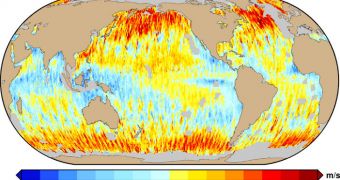Experts controlling the European Space Agency's (ESA) CryoSat mission are getting ready to start using the satellite for marine forecasting. This is made possible by the fact that its sensitive instruments can detect even tiny variations in wave height, even though it was built to measure sea ice thickness.
ESA sees no reason why it shouldn't use the spacecraft beyond the capabilities it was originally planned for. By measuring how tall waves are, and relating those data with readings collected by atmosphere-monitoring satellites, it may be possible to alert ships of potentially-dangerous situations.
CryoSat is injected in a polar orbit, which means that it can easily produce global maps of the ocean and ice sheets. As a secondary objective to monitoring polar ice fields, the spacecraft can also analyze the ocean's surface before its next pass over the poles.
The most interesting aspect of this secondary use is that the data CryoSat produces can be delivered to ESA nearly in real-time. By February 2012, this new capability is expected to be installed and accessible to end-users.

 14 DAY TRIAL //
14 DAY TRIAL //